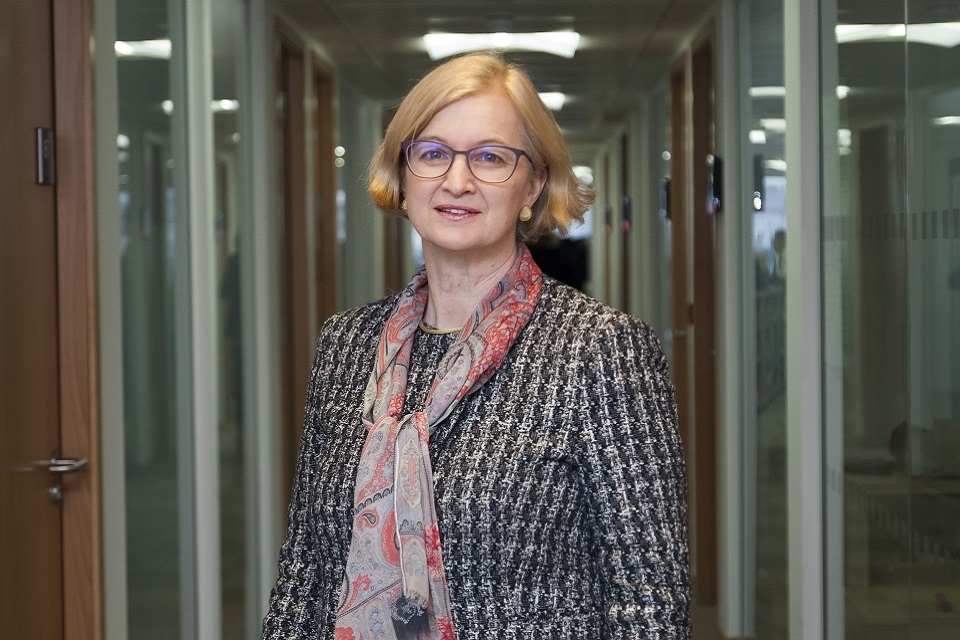Yes, there’s a hard path ahead, but I’m confident you’re up to the task

Amanda Spielman @Ofstednews discussed the impact of COVID-19 and recent work at the Association of Directors of Children’s Services (ADCS) annual conference:
Thank you for inviting me – though here’s hoping that virtual by default will soon be behind us!
I think to say it’s been an incredibly challenging year and a half for you all would be putting it mildly. At the sharp end, you’ve been helping schools get back on their feet, working with children and families in the most difficult circumstances, and so much more. Thank you for everything that you’re doing.
Looking back
No one here would disagree that the pandemic has been extremely damaging for many children. And of course, COVID has been tough on everyone. But, like you, we’re concerned with what’s best for children. And looking back, it’s children who’ve come last on the national priority list time and again.
We all want children to get the best start in life, and a good education lays solid foundations. Take these away, and what comes next becomes unsteady and uncertain. Most children have taken a knock over the last 16 months. But for some, the damage runs deeper and will take longer to fix.
Education sites have been closed to most children for so much of the last 16 months. Schools and colleges have struggled through, relying on remote learning – in some places better than others. But as we now know, even with good technology access, remote learning is no substitute for real classrooms and real teachers. Many young people are demoralised, and many have significant ground to make up.
Teenagers doing more practical courses at college lost out too – it’s been impossible to get the same experience at home. Not to mention young people doing on-the-job training or apprenticeships – so many facing severe disruption, at worst being furloughed or even losing their jobs. And for young people leaving school or college, the job market is clearly in turmoil.
Then there are the emotional side effects. Cooped-up children aren’t happy children. They miss their friends, the important social side of being at school or college. Children are resilient, and many are bouncing back now that life is opening up. But at the more severe end, some are really struggling, needing support for eating disorders, anxiety, self-harm and other serious issues.
And many toddlers and pre-schoolers have spent most of their young lives in lockdown – hardly an ideal start. Stuck inside, playgrounds shut, parents trying to work. We even saw some children regressing, reverting to nappies, losing the most basic skills during the first lockdown.
This disruption isn’t in the past, sadly. We’ve all seen the recent steep rise in absences – around 1 in 20 children out of school because of COVID. And of course, the vast majority haven’t got COVID, but are still being forced to miss out on school.
We seem to have carried on using children as an infection buffer for a very long time, given what we know about the risks to them and the risks that children pose to others. So, I’m pleased to see that the policy on bubbles and managing infection in schools is shifting. Children do just need to be in school.
Vulnerable children
And you’ll share our concerns about the most vulnerable children, the ones who fell from view. Last year, I talked about the COVID ‘pressure cooker’ taking its toll. So many families struggling to keep their heads above water in more ways than one.
With lines of sight obscured, and referrals down, it’s been hard to keep a watchful eye on children. And even though schools and colleges opened fully in April, referrals are only just returning to pre-pandemic levels. That’s a lot of missing referrals, and some of them would have been for children suffering significant harm.
And then there are the children who haven’t yet returned to school. The Centre for Social Justice reported that almost 100,000 children were still out of school last December. This fits with what we heard in our school visits last autumn.
Many parents have gladly stepped back from teaching duties, but some have kept their children at home. But for many children, there is so much ground to make up, and not every parent is equipped to be a teacher. This could seriously derail the catch-up effort.
And these are disproportionately children with various kinds of problem or need – schools can’t help children who aren’t there.
Of course, the vast majority of parents are responsible and competent. But, as you know all too well, a minority aren’t. I’m sure you share our concerns.
A more normal way of working
This bleak backdrop makes it all the more important for Ofsted to get back to normal working. You have a mammoth task ahead, and I genuinely believe that we have a constructive role here. Our insights are vital for you – the sector – just as parents and government need to understand how children are getting on.
No matter where we are on the roadmap, alas, COVID is still a live issue. So of course, we are fully aware of the pressures.
For children’s services, we’ll have managed to get to over half of you in some form by the end of this term. And so far, all indications are that you’re working hard to steady the ship and get back to some normality.
Some of you have managed to make improvements despite the pandemic, which is really good to see, while others have maintained a strong performance. And, more broadly, we’ve seen good work in response to COVID, from local authorities with lower ILACS judgements, as well as the more highly rated.
But some areas are struggling. This tends to be where authorities haven’t created an environment where good practice can thrive. I’m talking about lack of leadership oversight, large caseloads, and too many children not getting the services to keep them safely with their family. And some, sadly, experiencing harm for far too long before action is taken.
Throughout the pandemic, we carried on visiting children’s homes where we had concerns, and inspections restarted fully in April. Again, many homes have fared well. But some have deteriorated significantly, and unregistered placements are still a real concern. We know there’s a continuing sufficiency issue, and you’re often caught between a rock and a hard place in finding somewhere for children to live. But some placements have been patently unsafe and frankly unacceptable.
Looking to the autumn, we expect to be back to full ILACS in September, though of course, we’ll be taking local circumstances into account if we need to. And we’re working on the next iteration of the JTAI model. We hope that some of you will help us pilot a new model later this year.
For schools and colleges, we’re most concerned about making sure education is as normal as possible, as soon as possible. Everyone recognises what children have lost. It’s clear from many directions that remote education has been less effective than the normal kind. But for most children, as I’ve said so many times before – catch up will happen mainly in their usual classroom, with their usual teachers.
We’ll be returning to full routine inspection from September. There will no doubt be some trepidation about this. Though in fact, inspections this term have been welcomed by the dozens of schools that have been taken out of a category. And understanding how schools are getting children back on track couldn’t be more important.
Everything that we’re doing is about making sure children get as good an experience as possible. Our focus on education substance – the curriculum – hasn’t gone away, and I firmly believe it’s a positive lever here. We want to encourage schools to think properly about reshaping their curriculum, not just racing through to cover everything superficially.
Special educational needs and disabilities
This year has been so hard for many children with SEND. We’ve seen families exhausted to the point of despair. Children missing out on education, and struggling without their usual support services – despite the efforts of those working with them.
Nearly all our inspections either have a strand relating to children with SEND, or are entirely about them – in the latter category we have inspections of special schools and alternative provision, as well as area SEND inspections which restarted this term.
Local SEND systems were under pressure before COVID, which has only made them worse, particularly with the disruption to children’s health services.
Many of the old issues remain. Misdiagnosis is still a problem – children being wrongly labelled, simply because they haven’t been taught well, or given enough time and support to learn. While children with genuine needs are being missed or identified too late.
And joint working and commissioning across education, health and care – really the key in all this – are so often weak, with little clarity about who is responsible for what in an area.
As we return to normal, I hope things will improve for children and for families. But we’ve yet to see the impact on children whose assessments and diagnoses have been delayed. And we’re now in a position where children with SEND are even further behind their peers.
There’s no doubt that children and young people with SEND need to be front and centre of education recovery. But wholesale system changes are needed to make sure children are getting the best deal.
The government’s SEND review is an important opportunity to make the system work better, and we are using our insights to contribute all we can to it. Hopefully, you’ll have seen our reports setting out the findings from our recent interim visits.
Over the last year, we’ve been working with CQC on new area SEND inspections, and we’ll be consulting on the new approach soon. We want inspection to have a much sharper focus on how all partners are working together for children – encouraging everyone to play their part.
Ongoing challenges/joining up
So, COVID has brought new challenges and intensified old. This is true of the care system, too.
Mental health problems, substance abuse and domestic abuse all seem to be on the rise – with a knock-on impact on already stretched services.
The expected spike in children coming into care hasn’t happened, though the picture isn’t uniform nationally. But what’s clear is that the children you are identifying have very high levels of need. Meanwhile, jams in the family courts are stopping children both from entering and leaving care – with all that entails for children’s safety and welfare.
COVID restrictions have only increased the pressure, making it harder to meet children’s needs. We saw a small number of foster carers having to end placements due to shielding, for example. But children’s homes, foster carers and kinship carers have also been supporting children well in extremely difficult circumstances.
As I’ve mentioned, sufficiency is a huge challenge across the board. It’s widely accepted that there are too few foster and kinship carers to go around. And at the more severe end, we’re seeing high court judges still, reluctantly, having to approve unregistered placements.
We urgently need better analysis of children’s needs, and better planning – beyond local authority level – for children needing highly specialist placements.
There are no easy solutions here. But joining up is a start. Helping and protecting children and families can’t just rest with social care. This is about all agencies working together, and joined-up policy thinking across government.
For example, there have been some very good policies to reduce the numbers of children in the youth justice estate, or in in-patient care. But we haven’t had that joined-up needs analysis and commissioning to make sure there are the right community-based services to meet some children’s needs.
An unexpected benefit of COVID – at least at a local level – has been some green shoots when it comes to joining up. In some cases, the pandemic has helped agencies come together, with remote working and online meetings bringing the right people around the table. Let’s not lose those gains.
Sexual abuse review
This brings me on to our sexual abuse review, which I hope you’ve seen.
What we found was certainly shocking, if not surprising. Everyone knew that sexual harassment and online sexual abuse was happening to young people – but the sheer scale is appalling. Even more so, that so many children – especially girls – feel they have to accept this behaviour as part of normal life, to the point that they don’t think it’s worth reporting.
Everyone working with children – not just schools – needs to accept that this is an endemic issue. That means working on the assumption that sexual harassment will be happening, even if it isn’t evident.
And of course, schools and colleges have a vital role to play, but working between education and local partners needs to be stronger too. These issues aren’t just confined to the classroom or the playground.
We found a mixed picture in the review when it came to joining up. Some local safeguarding partnerships work well with schools, looking at the issues strategically as part of wider safeguarding work. But this isn’t happening everywhere.
A few partnerships said they weren’t aware of harassment and abuse being a significant problem in their area at all, which was clearly at odds with children’s experiences. Others found it hard to work well with the full range of schools. Equally, some schools with pupils from several areas said it was challenging to work with multiple local authorities.
As a first step, improving information-sharing with schools is crucial – so that everyone understands the effects on children and can respond appropriately. Clearer guidance would help to overcome some of these difficulties, as would more sharing of practice between partners, schools and colleges.
Looking ahead
Looking ahead, the road is challenging – both in the aftermath of COVID, and in terms of addressing the persistent system problems I’ve been talking about.
But there are some positives. The long-awaited care review is under way – and as you know, these opportunities to make real, lasting change don’t come around very often. We’re sharing our insights with the review team, and will be responding formally to the Case for Change.
So far, there are many areas we agree with. Not least around our own role, and creating a regulatory regime that fits the market as it operates today. We need clear regulations that set high standards for all types of care, and that are flexible enough to respond to children with complex needs and bespoke care arrangements.
The Case for Change also echoes what we’ve said about a more joined-up approach to vulnerable children across government, and better early help – making sure children and families are getting the right support at the right time.
And it raises some important questions about child protection investigations. As you know so well, these investigations are a significant event for any family, and never taken lightly. Decisions must be made quickly, sometimes with very limited information. Social workers rely on the quality of referrals and risk assessments from partners.
So, given this is a complex, nuanced area, we all need to look carefully at the reasons why these investigations are rising. We’ll be looking at our own data and findings to share them with the review team.
Our understanding is that many families do receive help after a section 47 investigation. We risk over-simplifying things if we look at child protection plans as the only route to help and support. We must look at the full picture.
And when authorities struggle, our inspections tend to show that they are too slow to get involved on a statutory basis, leaving children at high risk for too long. It’s not often that we find that the wrong child has been brought into care, or that child protection inquiries shouldn’t have been made.
Thresholds for removing a child are rightly very high, but sadly there will always be cases where it’s too risky or harmful for children to stay with their families. Raising that threshold would need careful planning, and everyone to play their part. And, crucially, significant investment in local services.
Ultimately, this is a multi-agency system, and we mustn’t lose sight of that. Safeguarding children requires a multi-agency response. It can’t be done by local authorities alone.
The review also raises some important questions about Ofsted – are inspections looking at the right things? Are they too bureaucratic?
We’ve worked hard over the years to make sure that inspection doesn’t take social workers away from that all-important direct work with families, and that we focus on the things that matter to children. Equally, there is always more we can do, more to learn, more to improve on.
But it would also be a mistake to underplay the importance of some core tasks, like reflective conversations between social workers and managers, and of course, case recording. These are children’s lives. Being able to see and understand decisions that have been made are so critical. And importantly, children and the care-experienced community tell us how valuable their records are to them as young adults, helping them make sense of a complicated past.
We look forward to discussing these issues with the review as it progresses.
Conclusion
I’ve spoken a lot today about challenges. Yes, there’s a hard path ahead, but I’m confident you’re up to the task.
Over the last year and a half, you’ve shown commitment and tenacity in the face of great adversity. While there’s much to do, it’s also clear that the wheels of recovery are well in motion. I’ve no doubt that when we meet again – in person I hope – children will be in a much better place.
Thank you.











Responses